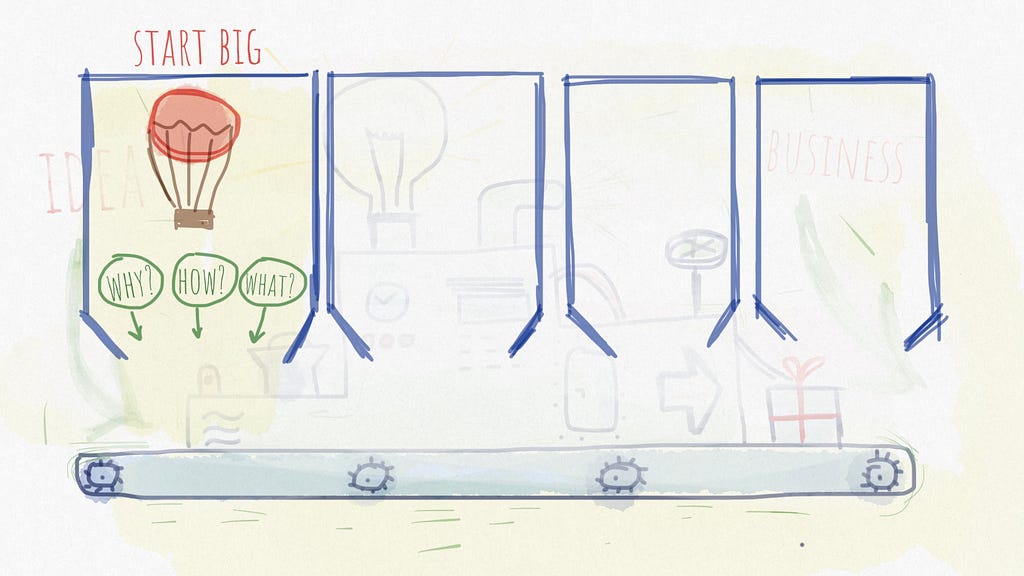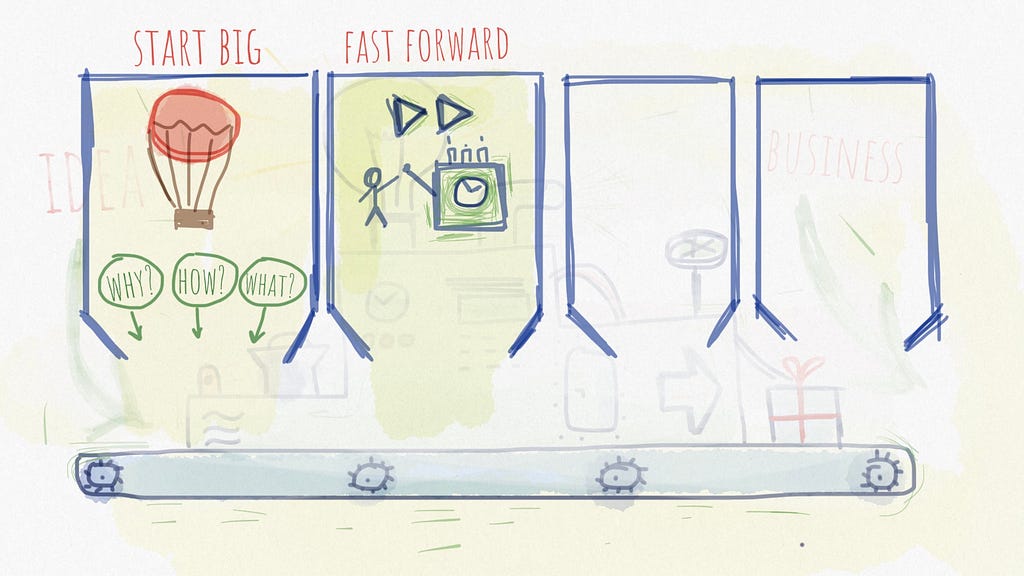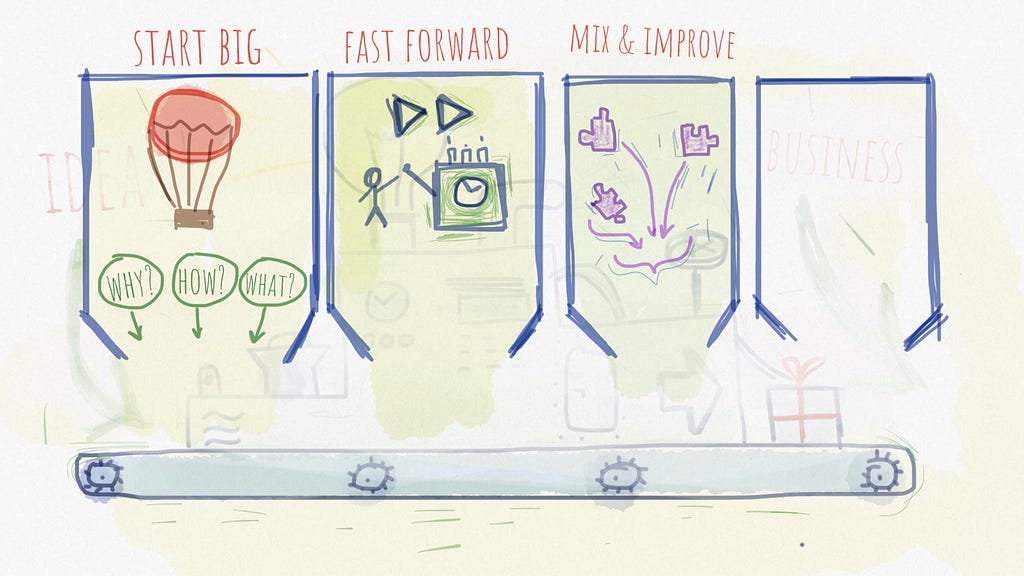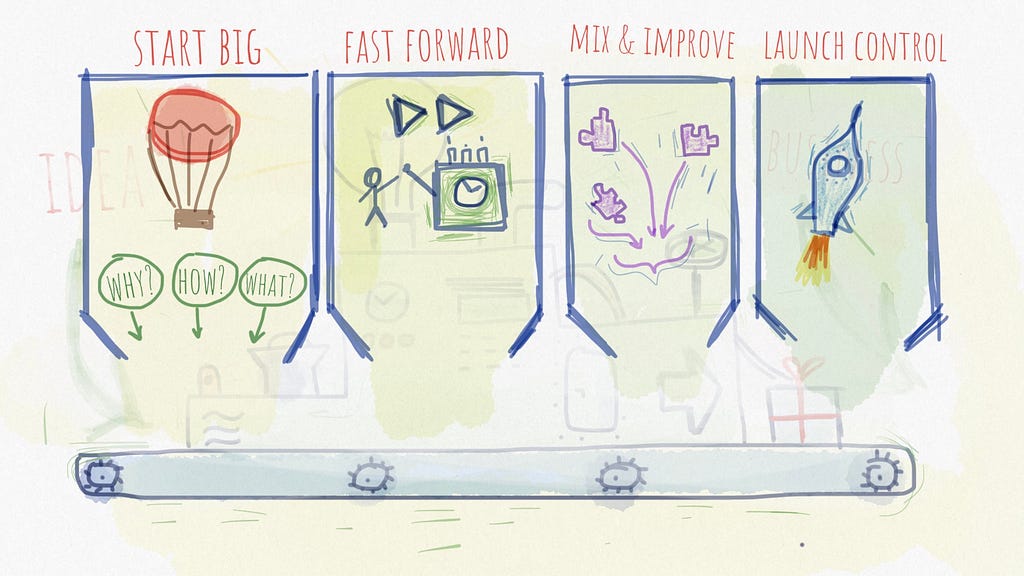Latest news about Bitcoin and all cryptocurrencies. Your daily crypto news habit.
Introducing my ultimate product development check-list which helped me and my business partners in creating a state of the art products and services.
I love talking about ideas with my friends and business partners. A good idea is the seed of every great start. But not every idea turns into a viable product or business. That partly happens due to bad assumptions and hypothesis. A bad business plan can also drive the idea to an undesired outcome.
This article is my ultimate product development check-list. It contains a list of actionable items which increase the likelihood of success in creating a great product or service. I've shared this list with many of my friends who are business owners as well as business partners I've worked with. They are all doing well today, partly because this list helped them in the process.
1. Start big
Every start needs a little push. You have a great idea for your pet project, side business or a physical product you want to sell, but you don't have a clue where to start from? Well, the good news is that every beginning looks like that. Nobody woke up with a complete master plan in their head. In order to beat procrastination, I suggest starting with a big picture. Give yourself a little bit of context to get into the appropriate state of mind. Imagine how your product looks like and how your buyers fell awesome by using it. The power of imagination is often underestimated. Imagination or auto-suggestion is a principle where affirmation or repeated instruction induced into the subconscious mind turns desire into a physical or monetary equivalent. The same applies to ones that don't believe in their goals. Their negative belief is turned into a phenomenon called "misfortune”. So dare to believe. Give yourself a permission to enjoy the riches that such mindset brings.
The purpose of creating a business plan is to remove uncertainties related to your product or service:
- The purpose uncertainty — “Why?” ,
- The means uncertainty — “How?” and
- The end uncertainty — “What”.
In my opinion, first and foremost is the purpose uncertainty (“Why?”). Why would you ever want to create what you’re about to create? As Simon Sinek says — always start with why. Ask yourself why do you want to build that feature. What is the core value that comes with it? What's in it for you? Only a small percentage of business owners get to answer the “Why?” question. Because it is hard. Because it requires reasoning from the first principles of your business and not reasoning by analogy. Your “Why?” should represent the things you believe in. For example, if you own a learning platform, you believe that everyone is able to learn a new skill. Also, you believe that everyone with a skill can transfer the knowledge to someone else. This kind of attitude will most definitely attract students and teachers who also believe that they can learn or teach. This makes the three of you a part of a group with similar beliefs. Being a part of the same group or tribe helps in building trust. Having trust affects the decisions that your customers make. Those decisions will be in your favor since now you belong to the same tribe.
Share your belief -> Attract those with the same belief -> Same belief builds a tribe -> Tribe builds the trust -> Trust drives decisions -> Decision controls the behaviour
Always be in a pursuit for the cause and the things you believe in. This approach will provide you with results such as fame or money or sometimes both. Again, by doing so and promoting your beliefs, you will attract those who believe what you believe. As a result, your product will prove what you and your customers believe in. This is a great pre-condition for a successful business so definitely spend some time figuring out your “Why?”.
People don’t buy what you do, they buy why you do it.
Removing the means uncertainty (“How?”) will reveal the tools and skills required for building the product you want to build. Having a glimpse of your end product is one thing. Knowing the tools for building it is a completely different aspect. Ideas are fine, ideas are the fuel, but when it comes to building the things you visualized in your head or your gut feeling tells you so, that tends to be really challenging. The answer to the “How?” question will indicate if you have enough resources to build the product. If you don’t, you will know who to hire or what tools and skills to acquire. For example, if you’re building a tech product, you have to be the architect of your product or to know who to hire for the task. Lay out the architecture, and determine the technology you find most suitable for the task. On the other hand, if it is a physical product, investigate what kind of machinery do you need, who can be your supplier or is there a manufacturing company which you can contact or hire.
The end uncertainty (“What?”) represents the lack of confidence about the end product. Having a strong vision and a strong belief will help you remove the end uncertainty. Start at the end and try visualizing the end product and how the users will benefit from it. This will give you a goal, and if you define it in enough detail and approach it with passion, this will be your driver when entropy kicks in and starts messing with your initial plans. Again, the product that you are building proves what you believe in. Keep that in mind and design it with a purpose to help others who believe in what you believe. After you’ve removed the purpose and the means uncertainty, defining what you want to build is so much easier. The answer to the “What?” question should be the tool which helps your customers in achieving the “Why?”.
2. Use your time-machine
Part of the business plan is envisioning your goal. In order to do so, you have to imagine how your business looks three, five or ten years from now.
Having just a glimpse of your business, product or service is not enough. You should envision all the details. And I mean all of them. The product, the package, the feel of the fabric or the layout of your digital product, the faces of your happy customers, their success stories where your product helped them and your face after you reach that goal.
As you probably know, it is much easier to solve problems which we've already faced in the past. Experience makes us more confident because we know that we have the skills to overcome the obstacles in front of us. But what happens when we have no experience in what lays ahead of us? How to start a business when we've never started one before? The closest thing you can get to experience of running a business is to imagine that it already happened. As I said before, the power of imagination and auto-suggestion is often underestimated. But based on my experience, auto-suggestion really works. If you envision your success with so many details, and if you repeat the whole scenario in your head for so many times, you will persuade your brain that it already happened. And when that happens, you've got yourself a great experience of what is about to be achieved.
Finishing a product is not the end of the road. Rather than that, the party has just begun. You will have to persuade the user that your product is just what they need. So you better be ready for that, because it is one of the most important stages in the process of product adoption.
What’s on the Box
We all use a lot of tools and products during the day. Even when we don't use them, we can imagine how they look and how they work. However, we probably can't remember how the package of the product looked like when we bought it. That's because now, we are focused on the benefits we enjoy by using it and the package doesn't matter anymore. But the package was extremely important when we were buying it. The package stated what benefits we were going to get from using it. The package made us choose it among all other similar products. The package made us interested in this product. Of course, it doesn't necessarily have to be the box. In case of digital products, it might be a landing page of your website.
Don't get me wrong, the “What's on the box” exercise is not about the package visual design. It's about asking yourself how will you describe your product to the users and how will you make sure that they understand how awesome they will become with the content of the package. Since you are selling your product, it is good to have in mind "the shoppers perspective". This describes the behavior of the prospective customer and their flow of thoughts and dilemmas. When the customer stumbles upon your product, he/she does the following:
- Notices the package
- Asks “what is it?”
- Wonders “Why should I care?”
- Wants to be persuaded
- Needs proof [*]
Answer those questions correctly and your product will end up in their shopping cart.
Awesomeness
People don’t buy your product or service because it's awesome, they buy because they want to become a better person, because of the value they want to have in their life, to become a better version of themselves. The focus is on them and their awesomeness. So be sure to envision how your product or service will make somebody awesome. This is the key for every successful product, service or business. If you have the power of making someone's life easier, that value will transform into a monetary equivalent. Value equals money, and if you provide good value, prospective customers will pay your bills in return for that value. Make sure that the value of the product is clearly stated. If the benefits are not clearly stated, they will most likely stick with what they already have.
Dependency
Among all other things, you should consider what could possibly hold you back. There can be a lot of dependencies related to your business. In case of digital products, you could develop a dependency towards your service provider (i.e. AWS) or framework used in your software (i.e. Vue.js). On the other hand, physical products might depend on your raw material supplier (i.e. textile manufacturer). Either way, you should build your business around something reliable and well established. You wouldn’t want to experience any downtime of your application in any stage of your business. Also, a shortage of materials could hold our production back and cause unwanted delivery delays. In any case, you should choose your providers wisely. Also, you should have a contingency plan or plan B in case when things go south.
Detect the obstacles
Similar to Fast Forward section, you should try to figure out what are the potential obstacles which you could face in future. But not in a pessimistic tone. Think of this exercise as a preventive maintenance of your business. Predict your potential failures in order to be one step ahead of it, and be ready to act before it may happen. Most of the time, we tend to take a happy path, a “blue sky day” approach. But have in mind that the storm happens every once in a while, and by identifying the obstacles upfront - you will be ready for it
3. Steal responsibly
To be honest, most of the products are putting old tools to novel use. There’s a handful of truly innovative products. Their brilliance alone is sufficient to put them in front of the competition.
Either way, if you’re looking for a disruptive solution or an incremental improvement, you should follow these steps:
Remix & Improve
When you start designing your product or service, think about existing solutions to a similar problem. Someone already spent a lot of time and money into solving a problem. Regardless of the time and effort invested, that solution might not be perfect. Every solution has its good parts and its bad parts. Identify the good ones and integrate them into your product. Identify the bad ones and avoid having them around. Of course, I’m not talking you into becoming a copycat. You should use the idea of a good solution and improve it. Remixing different solutions will spark your imagination and will enable you to detect disruption points of existing solutions. These incremental improvements will put you ahead of your competition. You will have feature parity as well as a competitive advantage because you made it significantly better.
I’m not a fan of reasoning by analogy, but unless your trying to innovate radically, this is usually the shortcut to the best solution.
Sketch
By now, you fell in love with the problem you are trying to solve. Also, the silhouette of a potential solution starts to emerge. Now is a good time to dive into details. We all have some sort of vision in our heads, and the vision seems complete. It seems complete until you try to explain all the details to somebody else, or even to explain it to yourself out loud.
By sketching out your solution, you will be forced to breathe life to your idea, even if you think it is not yet ready (but actually it is). By putting it on paper it comes to life because it is no longer just part of your imagination, it becomes real. In order to complete the whole drawing, you have to figure out every detail, even if you haven’t thought about them until now. This way, you will face obstacles before you even start building it, before you've spent a penny on the production. You have to agree that this is an extremely cheap prototype with an extremely high return on investment. Again, you're living it out before it even happened, gaining experience in what is about to become reality.
Sketching out your solution is the cheapest prototype you can get.
Communicating your vision can take a while. You've spent a lot of time thinking about your product or service, and during that time you've built your story one chapter at a time, completing the whole puzzle bit by bit in a random order. But when you're required to share your thoughts with somebody else, you have to use a lot of words. We as humans have very limited input-output verbal communication stream. We can only pronounce a limited set of information in a minute, and also, can hear that many sentences at a reasonable talking pace. And that kind of information sharing is sequential and therefore limited. However, our eyes can receive so much more information than our ears. This is why I like to sketch the vision of a product or service. A sketch on a paper can carry a ton of information. Our eyes can instantly feed the brain with so much information about the purpose, texture, size, practicality, usability, etc. And the information stream runs in parallel, so much faster than our ears.
Storyboard
Previously, you’ve created several sketches for your solution. Now is a good time to think about the steps which user has to take to discover your solution. Start at the very beginning — user opens the browser, or opens your app. What are the steps, clicks or taps which needs to be performed in order to get to the desired outcome? How many steps are there to be taken? The idea is to sketch out an entire journey through your product or service with enough detail so that everybody is aligned on what goes into the whole product.
Storyboard will help you create the whole product — a generic product augmented by everything that is needed for the customer to have a compelling reason to buy.
The storyboard is like a comic book —a set of scenes where the user interacts with your product. The storyboard will help you get the picture of how complicated is for the user to get where you want them to be. This way, you will identify missing steps or the one that is obsolete.
For example, you've developed a new TV with cutting-edge technology, fascinating pixel density, with picture indistinguishable from the reality. Then, you start building the storyboard, where the opening act is when the user walks into the store. The customer buys the TV and takes it home. But the problem is, the box can't fit the door opening. It can't fit the trunk either. You were so focused on building the best product, but you haven't thought about transportation. Furthermore, screws for the wall mount are not included in the package and the user has to go back to the store. Even though the TV is fantastic, the overall experience would be bad if you haven't had an awareness about all the things accompanying the product delivery. However, these situations would be avoided by sketching the complete storyboard.
Test
Before you launch it to the public, a good idea is to share the complete experience with a small group of people, in order to get an early feedback. This group of people could be your friends, your subscribers or existing customers. During the whole process of product development, we tend to get emotionally involved, and therefore biased. This can cause that we are aware that we have a flaw in the product, but we decide to look to the other side. Testing the whole product with a small group of people you trust will help you in getting valuable, unbiased feedback. Of course, don't get upset when people start pointing out some flaws or suggestions, they just want to help. Take note of the feedback and reiterate through the sketching and storyboarding process again and again.
4. Launch status check
You've done most of the hard work. Now, you can focus on those tiny details, to make sure everything is on point.
We all know about the Pareto principle, or 20:80 rule. For many events, roughly 80% of the effects come from 20% of the causes. In this case, you should ask yourself if you could build less and still retain the functionality and the quality of your product. We all want to build the perfect product or service. And all those details can inflate the final cost. But sometimes you should restrain yourself from overspending because the price will also be too high. Ideally, you should strike a balance between the cost and the number of details which will delight your customers. You don't want to go too high with the cost, but also, you want to have that WOW effect.
Milestone
Every launch has to have a planned date and time. Launching a rocket at a specific time and date is important because of the relative position of the planets, to hit the shortest path. Similarly, launching your product should hit the alignment of the market. Do the research about when is the highest demand for your product, when will the competitors do the launch, etc. Timing is very important, so keep that in mind.
Also, it's a good thing that you have the milestone for your launch because it will help you beat the procrastination. When the deadline creeps in, you will have to work hard to hit the “T-Minus” moment. Otherwise, the launch could be delayed indefinitely. So, do the research, open up your calendar and pick a date.
Arm yourself with knowledge
This article only scratches the surface of business development. There is a ton of other aspects about running a business, but this is a good starting point. For further read, I suggest reading about How to get good ideas, How to validate your idea, How to build a strong brand, How to write advertisements, How to build a roadmap and How to set the price for your product.
The important thing here is to know that you CAN succeed in building your dream business. The only thing holding you back is you. I believe that you can make your dreams come true, so why wouldn’t you believe in yourself? Wheter you believe that you can or can't, you are absolutely right.
Finally, here's a summary of this article, a cheat-sheet to kickstart you entrepreneurial aspirations:
- Why do you want to build this product? What do you believe in?
- How do you intend to build it?
- What exactly is your product?
- Can you imagine your success? How does it look like?
- What is on the box of your product? How will you attract your customers?
- How do you intend to make your users awesome?
- How can you fail? What kind of obstacles can you predict?
- Is there a similar product which you love? Can you make it better?
- Can you sketch your product with all the details?
- How does the customer experience look like? Is it a whole product?
- Can you cut the cost by reducing the scope of your product?
- When will you launch it?
You can do it. Good luck!
Got an idea? Translate it into a viable business was originally published in Hacker Noon on Medium, where people are continuing the conversation by highlighting and responding to this story.
Disclaimer
The views and opinions expressed in this article are solely those of the authors and do not reflect the views of Bitcoin Insider. Every investment and trading move involves risk - this is especially true for cryptocurrencies given their volatility. We strongly advise our readers to conduct their own research when making a decision.




